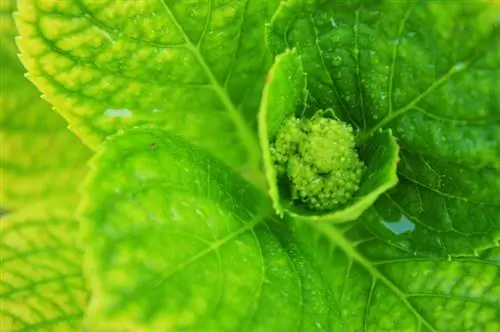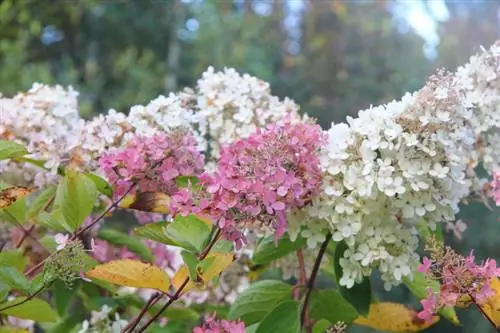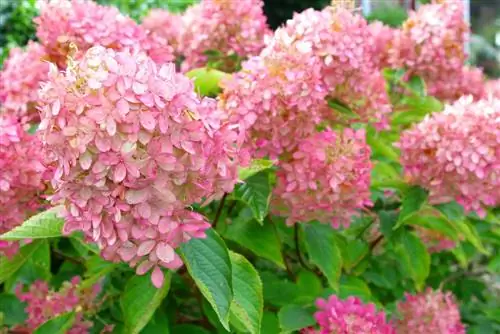- Author admin [email protected].
- Public 2023-12-24 06:09.
- Last modified 2025-06-01 06:02.
Thanks to the rigorous pruning in spring, panicle hydrangeas produce a lavish sea of flowers from summer to autumn. Hydrangea paniculata are subject to completely different pruning than classic farmer's hydrangeas. You can find out why this is the case here. Our practical tutorial explains when and how to properly cut your most beautiful summer bloomers.

When and how should you prune panicle hydrangeas?
Plumicle hydrangeas should be pruned in late winter to encourage abundant blooms in summer. A build-up cut in the first 4 years is important in order to build a stable framework. From the 5th year onwards, a shape and thinning cut follows to promote compact growth and flower formation.
Pruning doubles the number of flowers - that's why you should prune
In the growth behavior of the 80 types of hydrangeas, the panicle hydrangea is out of the ordinary in one respect. While using secateurs is usually taboo with farmer's hydrangeas (Hydrangea macrophylla), Hydrangea paniculata blooms even more luxuriantly after a courageous pruning. In fact, every cut on the respective shoot is rewarded with twice the number of flowers compared to the summer of the previous year. The explanation is very simple:
Panel hydrangeaslay their buds on this year's wood. Two leaf or shoot buds are located exactly opposite each other. If you follow the cutting instructions in this tutorial, both buds below an interface will be encouraged to sprout happily with numerous flower buds.
Target determines the type of cut - an overview
With the right cut, a well-shaped, lavishly flowering panicle hydrangea is within reach. No other type of hydrangea is as dependent on targeted pruning care, which begins in the first year. To ensure that your panicle hydrangea shows off its most beautiful side every year, the focus is on these 3 types of pruning:
| Cut Types | Target | Period |
|---|---|---|
| Build-up cut | well-formed framework | 1. up to 4th year |
| Shape and thinning cut | compact growth, opulent abundance of flowers | from the 5th year |
| Education to be a standard member | slender, stable trunk with a flower-rich, harmonious crown | starting with planting |
With the instructions for structure, shape and thinning pruning, this tutorial is aimed at home gardeners who want to have a flower-rich panicle hydrangea as an ornamental shrub in a bed or pot. The instructions for training pruning as standard stems are intended for the cultivation of panicle hydrangeas in small gardens, front gardens and containers.
Tip
In nurseries and garden centers, panicle hydrangeas are grown in containers. This has the advantage that you can plant the valuable flowering bushes at any time of the year in frost-free weather. In contrast to bare-root products, the young bushes receiveno pruning
Best time is in late winter
For a panicle hydrangea to be in full bloom from July, the cutting time must not be too late in the spring. The robust frost resistance of the hydrangea species means you can use scissors as early as the end of February/beginning of March. This choice of date also complies with the regulations of the Federal Nature Conservation Act. Heavy pruning of trees is permitted until March 1st because this is when the breeding season of native birds begins.
Instructions for the built-up cut
A well-proportioned panicle hydrangea does not form on its own. Compact habit and abundance of flowers are the result of expert pruning care right from the start. The aim is to build 5 to 7 scaffold shoots in order to achieve the desired bush height based on this structure over the first 4 years of growth. This is how the build-up cut works brilliantly:
- In the first year, select 5 to 7 of the strongest ground shoots and shorten them to 20 cm
- Cut off all others close to the ground
- From the second year onwards, extend the scaffolding shoots in stages up to the desired height
- Cut ground shoots without scaffolding function at ground level
Starting in the second year, you no longer cut all the shoots back to the same length. To achieve a natural growth habit, shorten the outer branches to 1 to 2 pairs of buds. Cut ground shoots positioned inside the bush back to 3 to 4 pairs of buds. In this way you give your panicle hydrangea a semi-circular dome shape, which is equally beneficial for large and small varieties.
Instructions for the shape and thinning cut
At the beginning of the fifth year, the build-up cut leads to an annual shape and thinning cut. If your panicle hydrangea presents itself with a stable framework of ground shoots that branch out near the base and bloom lavishly on the new wood every year, you have done everything right. To keep it that way, continue the pruning care as follows:
- From the fifth year onwards, remove 2 to 3 of the oldest ground shoots completely
- Cut strong young shoots back to 20 to 30 cm as a replacement, cut the rest off close to the ground
- Short outer side shoots to 1 to 2, inner side shoots to 3 to 4 pairs of buds
There is no reason to worry if your panicle hydrangea takes until April to produce new flowering wood. The deep cut is intended to bring floral life to the sleeping eyes at the base of the shoot. This process can take a few weeks and then sets in with all its might.
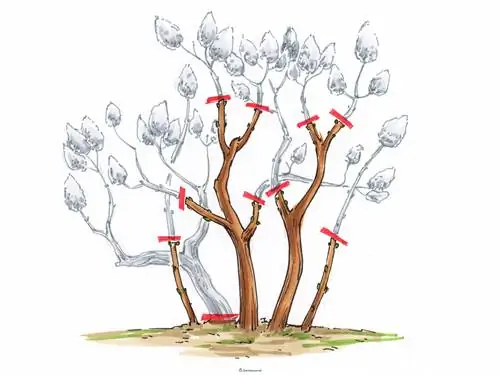
Light out bare, outdated scaffold shoots at ground level. Radically shorten the remaining annual branches to a height of 30 to 40 centimeters. At least two pairs of buds per shoot should remain.
Excursus
The cutting tool
For the annual shaping and thinning of a panicle hydrangea, you need sharp one-handed pruning shears. The tool should fit well in the hand, move smoothly and have shock absorbers so that you can work safely and without fatigue. Specialist retailers have just as extensive a range for left-handed gardeners as they do for right-handed gardeners. The choice between bypass or anvil mechanism is based on your personal preferences. If over-aged ground shoots with a diameter of more than 3 centimeters need to be cut, we recommend keeping a handy folding saw handy. Before cutting work, theblades should be sharpened and disinfected.
Education to be a standard member - this is how you do it right
A young panicle hydrangea is ideal for growing into a picturesque standard plant. The good-natured tolerance of pruning and the ability to sprout from sleeping eyes near the base of the shoots make the flowering hydrangea species a prime example of high-stem training. As a starting point, choose a grown young plant that has a strong central shoot with a height of between 60 and 100 centimeters. This is how you go about raising your child step by step:
Pruning in the year of planting
In the year of planting in the bed or pot, you determine the strongest central shoot for the future trunk. Cut off all vertically aligned competing shoots at ground level. Tie the main shoot to a support rod, as shown in the illustration below.
Education cut after one year
After the first year of standing, determine the trunk height and the position of the future crown. To do this, count 5 pairs of buds above the desired stem height on the main shoot. There you place the scissors over the upper pair of buds, as explained in the cutting technique section. During the summer growth phase, new shoots emerge from the buds and form a crown, as shown in the figure below.
Form and thinning cut in the following years
Once you have started the crown formation, the annual pruning aims to preserve the shape and promote the abundance of flowers. Every spring, remove shoots that compete with the trunk as well as side shoots that should not be part of the crown. Shorten the previous year's dead crown shoots to one or two pairs of buds. From the fourth year onwards, thin out the crown by completely removing old shoots. The aim of pruning is to create a crown flooded with light, the branches of which bear leaves and flowers from base to tip.
It's the cutting technique that counts - here's how it works
When making cuts, follow the rule of thumb: cut panicle hydrangeas at the buds. This premise applies regardless of whether it is an education or a training course. Please position the scissors in such a way that the thickened vegetation points are not injured and water can drain easily from the cut. Avoid a longer stump, which dies and hinders rapid wound healing. The image below shows how to do it correctly.
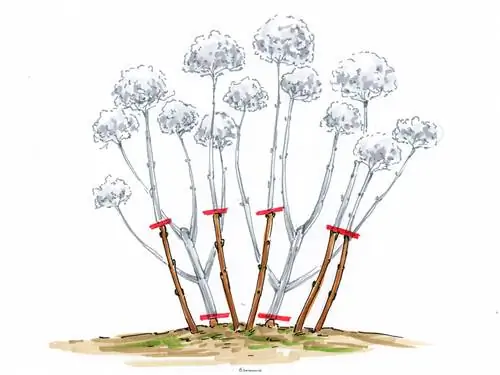
Cut to a pair of buds at a short distance. Make the cut at a slight angle away from the two opposing buds. A distance of 5 to 10 millimeters is ideal.
If a panicle hydrangea gets old, aging ground shoots are completely removed inside and out. With so-called thinning, you don't have to look out for leaf or flower buds. Place the scissors or saw near the ground to make room for fresh growth from the rootstock. If a small cone remains from the thinned ground shoot, it will dry out over the course of the summer, while fresh shoots will sprout from the rootstock elsewhere.
Profile with elementary facts about the cut
The following profile summarizes all the facts that are relevant to your decision about the right cut. If you are familiar with the key functions of growth, you will always know exactly when and how to professionally prune your panicle hydrangeas:
- Belongs to the genus Hydrangea (Hydrangea)
- Name of the species: panicle hydrangea (Hydrangea paniculata)
- Growth: perennial, upright, deciduous flowering shrub
- Growth height: 200 to 300 cm, dwarf varieties 100 to 150 cm
- Annual growth: 15 to 30 cm
- Flowering period: July to November
- Bud formation of flowers: on this year's wood
- Arrangement of buds: paired opposite
- Winter hardiness: good winter hardiness
- Cutting tolerance: excellent
- Poison content: slightly toxic
In contrast to the vast majority of popular farmer's hydrangeas, panicle hydrangeas require a rethink when pruning. At the beginning of the flowering period, farmer's hydrangeas already have the inflorescences for the next year's flowering period. Pruning care here is limited to cleaning out withered flowers in autumn or spring. There is still no sign of flower buds on panicle hydrangeas in early spring. The aim here is to use shape and thinning cuts to attract the fresh wood on which this year's inflorescences will then develop.
Frequently asked questions
Can I use cut shoots as cuttings?
In the cutting profile you can read that a panicle hydrangea blooms on new wood. The shoots that were cut off from the previous year only have a low level of vitality. If you want to propagate the summer flowering plant with cuttings, wait until June/July. Life pulsates in the fresh shoots of a panicle hydrangea, making the shoot tips ideal for use as cuttings.
Cut off spent flowers in autumn or not?
Many home gardeners find the withered flowers to be a visual nuisance in the autumnal appearance of the garden. It will not affect next year's flowering if you clean out a panicle hydrangea in the fall. Cut off a withered flower above a pair of leaves. In mild winter locations, you can use this opportunity to carry out the complete shaping and thinning cut.
3 typical editing mistakes
Are you struggling with a panicle hydrangea whose shape is reminiscent of an old shaving brush, has hardly any leaves inside and is blooming noticeably less? Then please take a look at these 3 typical pruning mistakes that home gardeners often make:
| Error | Episode | Correction |
|---|---|---|
| never photographed | impenetrable, dense branching, few flowers on the tips of the shoots | thin out old ground shoots regularly, maintain bush training with 5 to 7 scaffold shoots |
| pruning too timidly | increasing baldness from below, decreasing flowering ability | Annual heavy pruning of all shoots by up to two thirds |
| all branches cut back linearly to the same height | unnatural growth form that falls apart | Cut shoots inside the bush to 4 pairs of buds, shorten outer branches to 2 pairs of buds |
Can you identify one of these common mistakes as the cause of a spoiled panicle hydrangea? Then don't be afraid to radically shorten the entire shrub next spring. The good-natured pruning tolerance allows you to once again bring the ornamental tree to new splendor with the structure, shape and thinning pruning in this tutorial.

Tip
Transplanting a panicle hydrangea is inextricably linked with pruning. Moving to another location is accompanied by a loss of root volume. This loss is compensated for by cutting back the shoots in proportion. This premise applies regardless of whether you move the flowering bush in autumn or spring.


